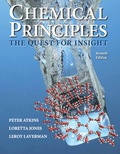
Concept explainers
(a)
Interpretation:
Volume of sample at
Concept Introduction:
An ideal gas contains a large number of randomly moving particles that are supposed to have perfectly elastic collisions among themselves. It is a theoretical concept. Gases that show perfect elastic collision are practically not possible. At higher
Here,
(a)
Answer to Problem 3B.17E
Volume of sample at
Explanation of Solution
Ideal gas equation is also expressed as follows:
Here,
Moles of
So the modified ideal gas equation is as follows:
Rearrange equation (2) to calculate
The conversion factor to convert
Substitute
Hence, volume of sample at
(b)
Interpretation:
Pressure of sample at
Concept Introduction:
Refer to part (a).
(b)
Answer to Problem 3B.17E
Pressure of sample at
Explanation of Solution
The conversion factor to convert
Rearrange equation (2) to calculate
Substitute
Hence, pressure of sample at
(c)
Interpretation:
Temperature for xenon at
Concept Introduction:
Refer to part (a).
(c)
Answer to Problem 3B.17E
Temperature for xenon at
Explanation of Solution
Since volume remains constant so
So the modified ideal gas equation is as follows:
Rearrange equation (5) to calculate
Substitute
Hence, temperature for xenon at
Want to see more full solutions like this?
Chapter 3 Solutions
EBK CHEMICAL PRINCIPLES
- You have two pressure-proof steel cylinders of equal volume, one containing 1.0 kg of CO and the other containing 1.0 kg of acetylene, C2H2. (a) In which cylinder is the pressure greater at 25 C? (b) Which cylinder contains the greater number of molecules?arrow_forwardMass of a vacuumed (empty) vessel of volume 5 L is 640.05 g, and mass of the same vessel filled with this hydrocarbon up to the pressure 2.0 atm at 22 oC is 658.23 g. What is the molecular formula of the hydrocarbon?arrow_forwardEthanol, C2H5OH, and carbon dioxide, CO2, have approximately the same molecular mass,yet carbon dioxide is a gas at STP and ethanol is a liquid. How do you account for thisdifference in physical property?arrow_forward
- In what volume must 12.5 moles of argon be contained so that at 20.0°C it would exert a pressure of 50.0 atm?arrow_forwardDetermine the density of CO2 at 745 mmHg and 65 degrees C?arrow_forwardIf 1.00 kg of ammonium nitrate is sealed into a 50.0 L steel drum and heated to 787 degrees Celsius, what is the pressure in the drum, assuming 100 percent decomposition?arrow_forward
 Chemistry: The Molecular ScienceChemistryISBN:9781285199047Author:John W. Moore, Conrad L. StanitskiPublisher:Cengage Learning
Chemistry: The Molecular ScienceChemistryISBN:9781285199047Author:John W. Moore, Conrad L. StanitskiPublisher:Cengage Learning Chemistry: Principles and ReactionsChemistryISBN:9781305079373Author:William L. Masterton, Cecile N. HurleyPublisher:Cengage Learning
Chemistry: Principles and ReactionsChemistryISBN:9781305079373Author:William L. Masterton, Cecile N. HurleyPublisher:Cengage Learning General, Organic, and Biological ChemistryChemistryISBN:9781285853918Author:H. Stephen StokerPublisher:Cengage Learning
General, Organic, and Biological ChemistryChemistryISBN:9781285853918Author:H. Stephen StokerPublisher:Cengage Learning Chemistry & Chemical ReactivityChemistryISBN:9781133949640Author:John C. Kotz, Paul M. Treichel, John Townsend, David TreichelPublisher:Cengage Learning
Chemistry & Chemical ReactivityChemistryISBN:9781133949640Author:John C. Kotz, Paul M. Treichel, John Townsend, David TreichelPublisher:Cengage Learning Chemistry & Chemical ReactivityChemistryISBN:9781337399074Author:John C. Kotz, Paul M. Treichel, John Townsend, David TreichelPublisher:Cengage Learning
Chemistry & Chemical ReactivityChemistryISBN:9781337399074Author:John C. Kotz, Paul M. Treichel, John Townsend, David TreichelPublisher:Cengage Learning Chemistry: Principles and PracticeChemistryISBN:9780534420123Author:Daniel L. Reger, Scott R. Goode, David W. Ball, Edward MercerPublisher:Cengage Learning
Chemistry: Principles and PracticeChemistryISBN:9780534420123Author:Daniel L. Reger, Scott R. Goode, David W. Ball, Edward MercerPublisher:Cengage Learning





